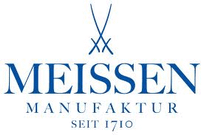Period: 1916 -
Region: Germany
西元1906由Eduard Haberländer於Windischeschenbach籌備,但是一直到1913年他的計畫才開始被落實。1916年首批生產的範圍僅限於一般簡單較便宜的產品。生產能力在當時仍然很有限。
於1929年期間, 工廠被位於Schwarzenbach (Saxony-Anhalt) 的Porzellanfabrik Oscar Schaller & Co. Nachfolger接管。在當時,這個公司隸屬於位在Röslau (上弗蘭肯行政區,巴伐利亞州)的Gebrüder Winterling O.H.G.。新的生產概念也在這個時期被導入,Eschenbach商標下所生產的產品也因此從此被改變,這個品牌也因此出現新的變化與契機。於1935年,Eschenbach的地位終於被建立,從此展開正面的經濟效應。但可惜的是Eschenbach品牌不敵無情的戰火,在第二次世界大戰中,再次被烙上傷痕! 最遺憾的是,在戰爭中驅逐美軍期間,幾乎所有的Eschenbach瓷器設計,小冊子,傳單,以及所有的公司文件都遭到遺失。也因此只有極少數於1912年至1945年期間所生產的Eschenbach瓷器仍被幸運得被保存下來! 二戰結束後的第一個十年,民生物資需求大量倍增,在現代化量產工業快速擴張下,精緻工業很自然得被淘汰了,Eschenbach品牌也因此曾一度幾乎消失。
於西元1950年,Eschenbach的結構再一次出現巨大的改變。具法人地位的“Winterling公司“ 決定出釋股份,從此主要股東都隸屬於”Winterling“家族成員。所有子公司都重新被命名為'Gebrüder Winterling A.G,大多數沿用到當時的商標也必須被改變。從此Winterling (前Eschenbach) 不再生產家用瓷器,進而開始專注於生產酒店用瓷。於1977年左右,聘用工人人數達約700名。
於2000年11月Winterling A.G. 破產,工廠和商標被位於Triptis (Thuringia圖林根州) 的Triptis Porzellan G.m.b.H. & Co. K.G.接管,並重新以Eschenbach Porzellan為商標,生產高品質家庭及酒店用瓷。但是很遺憾的是,Triptis公司似乎只對Windischeschenbach的商標有興趣,對於生產動力缺缺,並於2003年12月關閉了工廠! 但是一個公司的生存並不能單單只依靠擁有商標,所以很快的Triptis公司便面臨大規模的財政問題,並於2004年10月7日破產了。
於2005年6月Triptis公司重新被建立,命名為Neue Porzellanfabrik Triptis G.m.b.H,Eschenbach這個品牌以及其業務終於再一次得以被延續,直到今日。
The founder of the factory and councilor to the board of commerce Eduard Jaberländer had been planning such a facility in Windischeschenbach since 1906 but it took until 1913 before he could finally realize his plans. First production started in 1916 and was restricted to staple commodities, the product range was cheap and simple and production capacity was still very low.
During 1929 the factory was taken over by Porzellanfabrik Oscar Schaller & Co. Nachfolger located in Schwarzenbach (Saxony-Anhalt), which at that point was a branch of the Gebrüder Winterling O.H.G. in Röslau (Upper Franconia, Bavaria). Based on a new concept, products under the 'Eschenbach' mark were changed. Up until 1935, the status of quality porcelain had been established, resulting in a strong economic upturn. But World War II left scars even in Windischeschenbach. The reason that only a small range of china from the 1913 to 1945 period still exists is that all china design ranges as well as all brochures and leaflets and nearly all company documents and correspondence were lost during the eviction by American soldiers. For the first ten years after World War II, the factory went through an extensive expansion and modernization process with a later total of five tunnel kilns without a loss of production capacity.
In 1950, the 'Winterling' company had corporation status and gave out shares, the main shareholders being the 'Winterling' family members. All daughter companies were re-named to 'Gebrüder Winterling A.G.' and most marks used up until then were changed. Next to normal household products, the factory started to specialize on hotel porcelain and around 1977 employed approximately 700 workers.
After the bankruptcy of the 'Winterling A.G. in November 2000 the factory and mark were taken over by the Triptis Porzellan G.m.b.H. & Co. K.G. located in Triptis (Thuringia). The factory produced high quality household and hotel porcelain under the trademark 'Eschenbach Porzellan'. The Triptis management seemed only to be interested in the trademarks related to the Windischeschenbach facility and closed the factory in December 2003. But a company can not survive alone with a bunch of trademarks and soon it was obvious that the Triptis management had bitten off more than they could chew. Confronted with large scaled financial problems, Triptis themselves went insolvent on October 7th 2004 and had to file for bankruptcy a month later. In June 2005 the Triptis company was refounded as 'Neue Porzellanfabrik Triptis G.m.b.H.' and continued business.
Eschenbach 以及 Winterling不同時期所使用的商標:






 )
)






